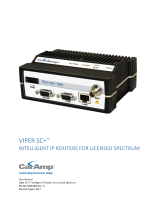
Prepared by Document
Jon-Olov Vatn Release Notes WeOS 5.9.2
Approved by Date Document No
Jonas Nylander October 22, 2020 224004-gd985aa6
Issue Category Description
# 18098 MRP After reconfiguration MRP may block ports for 40 seconds
# 18119 Link Aggregation Aggregates do not handle incoming traffic correctly when a physical
port in considered logically down by LACP/TTDP (Viper-TBN)
4.1 #18045: Work-around and heads-up on upcoming WeOS 5.10 change in default
VLAN MAC assignment
In WeOS 5, a VLAN network interface (vlan1, vlan2, …) by default inherits its MAC address from one
of its associated ports (eth1, eth2, …). From the next feature release (5.10) and onwards, all VLAN
network interfaces will instead use the unit’s base MAC address as their MAC address. Information
on this will be included in the 5.10 release notes, thus information here is primarily a heads-up.
In most setups, a future upgrade to 5.10 will go smoothly. The exception is when the VLAN interface
MAC is used for specific purposes, e.g., when a DHCP server assigns IP address to the WeOS 5 unit
based on its MAC address. If that is the case, it is recommended that you already now start to prepare.
• In case you need to keep your existing VLAN MAC, you can configure it statically, overriding
the WeOS default MAC assignment algorithm.
example:/#> show iface
INTERFACE OPER ADDRESS/LENGTH SOURCE MAC/PTP ADDRESS
lo UP 127.0.0.1/8 static 00:00:00:00:00:00
vlan1 UP 192.168.2.23/24 static 00:07:7c:1c:cf:a1
169.254.69.180/16 link-local
vlan2 UP 192.168.5.11/24 static 00:07:7c:1c:cf:a8
example:/#> configure
example:/config/#> iface vlan1
example:/config/iface-vlan1/#> mac 00:07:7c:1c:cf:a0
example:/config/iface-vlan1/#> end
example:/config/#> iface vlan2
example:/config/iface-vlan2/#> mac 00:07:7c:1c:cf:a8
example:/config/iface-vlan2/#> leave
• In the specific example where a DHCP server assigns IP addresses based on the unit’s MAC,
you could consider changing the assignment algorithm to use clientid or option82 (Port ID).
Alternatively, the DHCP server could be prepared to use the unit’s new MAC address, the base
MAC, when assigning the IP address. The base MAC of the unit can be found in several ways,
e.g., using the “show system-information” CLI command.
The rationale for shifting the default VLAN assignment mechanism relates to issue #18045: The MRM
switch is unreachable if ring port is ’lowest port’ on VLAN (RedFox/Lynx)”, see list of known issues
above.
The problem can occur between an MRM(B) and its neighbor(A) on the link with the blocked port. In
short, when A wish to communicate with B, it should send packets through port 1 towards D, which
14 Copyright © 2020 Westermo Network Technologies AB






















